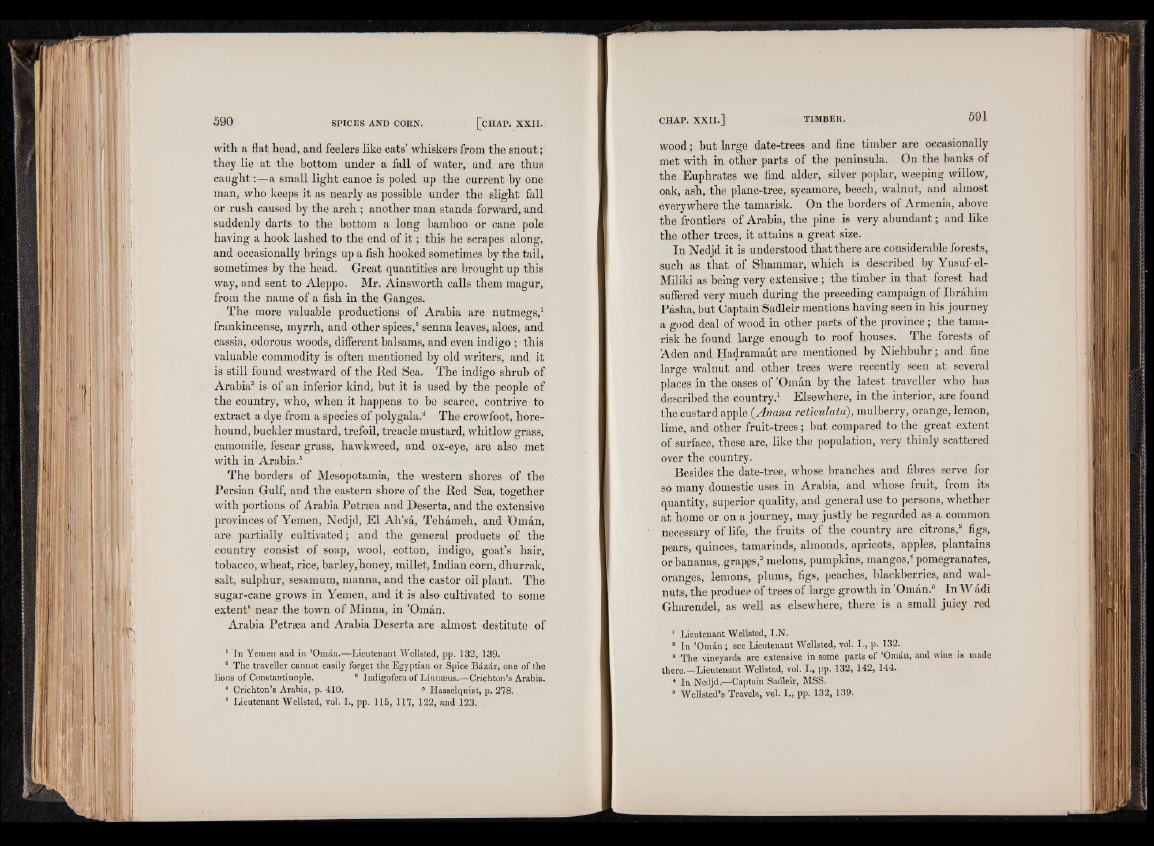
with a flat head, and feelers like cats’ whiskers from the snout;
they lie at the bottom under a fall of water, and are thus
caught:—a small light canoe is poled up the current by one
man, who keeps it as nearly as possible under the slight fall
or rush caused by the arch ; another man stands forward, and
suddenly darts to the bottom a long bamboo or cane pole
having a hook lashed to the end of i t ; this he scrapes along,
and occasionally brings up a fish hooked sometimes by the tail,
sometimes by the head. Great quantities are brought up this
way, and sent to Aleppo. Mr. Ainsworth calls them magur,
from the name of a fish in the Ganges.
The more valuable productions of Arabia are nutmegs,1
frankincense, myrrh, and other spices,2 senna leaves, aloes, and
cassia, odorous woods, different balsams, and even indigo ; this
valuable commodity is often mentioned by old writers, and it
is still found westward of the Red Sea. The indigo shrub of
Arabia3 is of an inferior kind, but it is used by the people of
the country, who, when it happens to be scarce, contrive to
extract a dye from a species of polygala.4 The crowfoot, hore-
hound, buckler mustard, trefoil, treacle mustard, whitlow grass,
camomile, fescar grass, hawkweed, and ox-eye, are also met
with in Arabia.6
The borders of Mesopotamia, the western shores of the
Persian Gulf, and the eastern shore 7 of the Red Sea,3 toogether
with portions of Arabia Petrsea and Deserta, and the extensive
provinces of Yemen, Nedjd, El Ah’sá, Tehámeh, and Omán,
are partially cultivated; and the general products of the
country consist of soap, wool, cotton, indigo, goat’s hair,
tobacco, wheat, rice, barley,honey, millet, Indian corn, dhurrak,
salt, sulphur, sesamum, manna, and the castor oil plant. The
sugar-cane grows in Yemen, and it is also cultivated to some
extent6 near the town of Minna, in ’Omán.
Arabia Petrgea and Arabia Deserta are almost destitute of
1 In Yemen and in ’Omán.—Lieutenant Wellsted, pp. 132, 139.
s The traveller cannot easily forget the Egyptian or Spice Bázár, one of the
lions of Constantinople. 8 Indigofera of Linnaeus.—Crichton’s Arabia.
4 Crichton’s Arabia, p. 410. 5 Hasselquist, p. 278.
6 Lieutenant Wellsted, vol. I., pp. 115, 117, 122, and 123.
wood; but large date-trees and fine timber are occasionally
met with in other parts of the peninsula. On the banks of
the Euphrates we find alder, silver poplar, weeping willow,
oak, ash, the plane-tree, sycamore, beech, walnut, and almost
everywhere the tamarisk. On the borders of Armenia, above
the frontiers of Arabia, the pine is very abundant; and like
the other trees, it attains a great size.
In Nedjd it is understood that there are considerable forests,
such as that of Shammar, which is described by Yusuf-el-
Miliki as being very extensive ; the timber in that forest had
suflered very much during the preceding campaign of Ibráhím
Pásha, but Captain Sadleir mentions having seen in his journey
a good deal of wood in other parts of the province; the tamarisk
he found large enough to roof houses. The forests of
Aden and Hadramaút are mentioned by Niehbuhr; and fine
large walnut and other trees were recently seen at several
places in the oases of ’Omán by the latest traveller who has
described the country.- Elsewhere, in the interior, are found
the custard apple (Anana reticulata), mulberry, orange, lemon,
lime, and other fruit-trees; but compared to the great extent
of surface, these are, like the population, very thinly scattered
over the country.
Besides the date-tree, whose branches and fibres serve for
so many domestic uses in Arabia, and whose fruit, from its
quantity, superior quality, and general use to persons, whether
at home or on a journey, may justly be regarded as a common
necessary of life, the fruits of the country are citrons,2 figs,
pears, quinces, tamarinds, almonds, apricots, apples, plantains
or bananas, grapps,3 melons, pumpkins, mangos,4 pomegranates,
oranges, lemons, plums, figs, peaches, blackberries, and walnuts,
the produce of trees of large growth in ’Omán.5 In W ádi
Gharendel, as well as elsewhere, there is a small juicy red
* Lieutenant Wellsted, I.N.
8 In ’Omán; see Lieutenant Wellsted, vol. I., p. 132.
8 The vineyards are extensive in some parts of ’Omán, and wine is made
there.—Lieutenant Wellsted, vol. I., pp. 132, 142, 144.
4 In Nedjd.—Captain Sadleir, MSS.
5 Wellsted’s Travels, vol. I., pp. 132, 139.